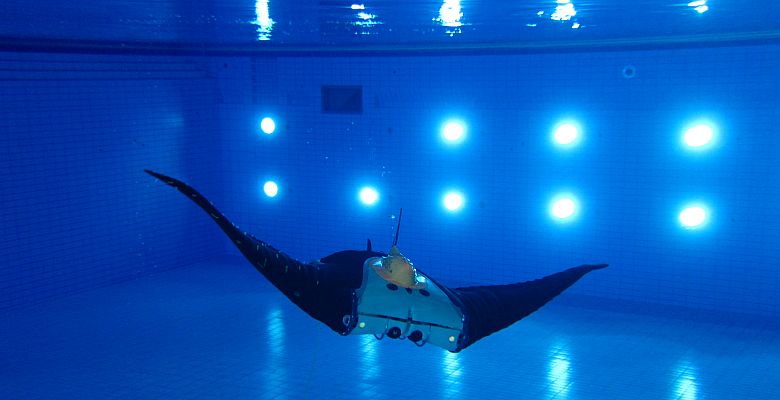A new underwater robot should reduce the risks for specialised divers.
Up to now, special submarines have been used to reliably detect ammunition that has sunk into the sea. For narrow, difficult to reach places, specially trained divers still take on this complex and dangerous task. A German research consortium is using an underwater robot that is as agile and manoeuvrable as a stingray.
Thanks to newly developed sensors networked into its wing surfaces, it will be able to obtain more information from its surroundings in the future. For example, it will be able to measure the ambient pressure, allowing it to detect metal objects on the sea floor, even if they are lightly buried.
Robotic ray
High-tech underwater communication and bionic solutions companies such as EvoLogics in Berlin are developing autonomous underwater vehicles (AUVs) inspired by animals such as rays, visually and anatomically adapted to the marine world. With their wingspan of fins, the real fish can cover large areas, but thanks to their movable vertebrae, they can also achieve small bending radii and glide easily through the sea.
So far, robot rays are not yet smart enough to replace divers. For example, prior to the expansion of an offshore wind farm or intercontinental pipelines, divers spend hours searching the seabed for sunken munitions from the First and Second World Wars or other metals. An electrical solution in the form of a robotic ray should make it possible to detect hazardous substances underwater safely using a variety of sensors.
Sensor skin
In the Bionic RoboSkin project, the robotic rays are given a flexible bionic sensor skin that allows the UAV to find its way autonomously. The sensor skin consists of a textile composite as a carrier for the sensor elements and provides moisture resistant electrical connections for power supply and communication.
Researchers at the Fraunhofer Institute for Sensor Safety and Microintegration (IZM) in Berlin have taken on the task of developing the integrated sensor modules. These will allow the AUVs to detect and analyse touches, as well as explore their surroundings. The project consortium is led by EvoLogics in Berlin.
The common goal is to create a new generation of robots that can support people with a variety of partially or fully automated services. But the new robots are not only intended to make construction underwater safer: For a second application scenario, the researchers are transferring the sensor platform to a land robot, the 'badger'.
Technology
The robots will be equiped with a textile, moisture-permeable and thus pressure-neutral skin. The microelectronics integrated in it enable the functions of touch, position, flow and motion sensors. This textile skin is pulled over the robot's wings like a sock and makes them sensitive in the style of soft robotics.
Fraunhofer IZM is responsible for the hardware. The technicians build underwater sensor nodes that preprocess the data collected by the robotic robot. These nodes must not only be functional, but also highly miniaturised so that they can be fitted and wired directly under the thin textile skin. During operation, the sensors measure variables such as acceleration, pressure and moisture permeability.
The researchers have also integrated light emitting diodes/LEDs into the design of the circuit board. By activating the lights, the robot will be able to communicate with divers underwater and, for example, blink to indicate that it is about to turn.
All these components and sensor packages were integrated using highly miniaturised embedded technology and are protected from external influences, such as cold and liquid, with a robust module housing.
Next steps
In the next steps, researchers at Fraunhofer IZM and the project partners will subject the robotic ray to initial tests. The findings and results of Bionic RoboSkin can be used in other projects to advance maritime sensor technology and other flexible and mobile service robots by developing pressure-neutral and reliable packaging solutions and making them even smarter.
Photo: EvoLogics

